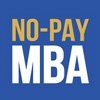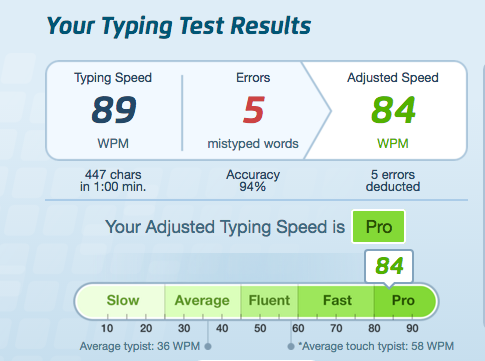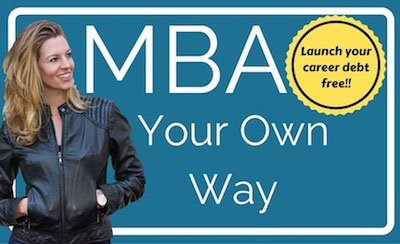by Laurie Pickard | May 25, 2018 | Career Development

Of all the chapters in my book Don’t Pay For Your MBA (HarperCollins, 2017), my favorite to write was Chapter 5. That’s because Chapter 5 is about how to craft your career, a topic that I find endlessly fascinating. In my book, I suggest approaching your career as a series of hypotheses and experiments, just as an entrepreneur who uses Design Thinking would approach designing a new product. I also emphasize the importance of innovation, creative thinking, and storytelling. I believe that every career (and every life) is a story in progress. The better you become at piecing together the bits of that story into a coherent narrative, the more easily you can convince other people (potential employers, bosses, investors, etc.) of what your next step ought to be and why you are ready to take it.
This process of crafting a narrative story out of your life and career relates directly to the question I am most frequently asked about the No-Pay MBA project: What can you do with a self-directed business education? It’s a question that is probably on your mind as well if you’re considering going down the DIY MBA path.
When I wrote the book, I didn’t yet know what my next step would be. At the time, I was working for the U.S. Agency for International Development in Rwanda and running No-Pay MBA as a side project. In Chapter 5, I wrote some of my hypotheses about what my next career step would be. These included starting my own consulting business, continuing to work for USAID, and joining a startup in educational technology.
Shortly after I finished writing the book, I got an email from Dhawal Shah, the founder of Class Central. For those who don’t know it, Class Central is the best search engine and review site for MOOCs. I used the site a ton during my studies, and I had connected with Dhawal as a fellow entrepreneur in the MOOC space. As his business was growing and he found himself in need of new talent, he thought of me. His message came at just the right time. I am now working for Class Central as part of the core team. Because Class Central is a startup, that means doing whatever needs doing, from writing articles to attending conferences to strategizing about the direction of the business. Although I couldn’t have foreseen stepping into this particular role even a few months before it happened, it is a perfect fit.
Will a No-Pay MBA be part of your story?
This blog is a chronicle of my experience using free and low-cost resources from the internet (primarily MOOCs) to create my own version of an MBA, a project I started in 2013. I’m not blogging as much these days, since I finished the education and put all of my best insight into the book. Now, my main goal with this website is to reach the people who can benefit from reading my book. You may be here because you are researching options for affordable business education. If that is the case, then you may be one of the people I am trying to reach.
Whenever I am deciding whether I need a book, I like to listen to the author talk about their work. If the same if true for you, and you are deciding whether you need Don’t Pay For Your MBA, you can hear me on some of the podcast interviews I’ve done surrounding my book launch. These include the How To Be Awesome At Your Job Podcast, Everyday MBA, and StartEdUp.
I’m also happy to hear from you, whether you are considering pursuing a self-directed business education, or if you’ve started down that path. I love connecting with self-directed learners who are considering or have pursued the NPMBA method. If you want to get in touch, the contact form on this website is a direct line to my inbox.
Here’s wishing you the best of luck writing the next chapter in your story!
-Laurie
by Laurie Pickard | Feb 2, 2018 | Career Development, Courses, Platforms, and Profs
This Silicon Valley venture capitalist turned Udemy entrepreneur will teach you everything you need to know to succeed in business.

Note: This post contains affiliate links.
Chris Haroun has found a calling. Having spent time in a variety of high-profile business careers, including financial analysis, management consulting, and Silicon Valley venture capitalism, he now spends his days creating courses as one of the most popular instructors on the learning platform Udemy.
I first wrote about Chris Haroun’s blockbuster Udemy course An Entire MBA in 1 Course back in 2016. Especially after having taken so many academic business school courses from the major MOOC platforms, I was impressed by how comprehensive, practical, and enjoyable Chris’s course was.
Since then, Chris has created a veritable business school on Udemy. In addition to An Entire MBA in 1 Course, he now has courses on finance, management, accounting, personal productivity, job interviews, and many other topics. Not only that, his flagship course has been translated into 11 languages.
While “online course instructor” may seem an unlikely profession for someone with Chris’s background, it is in fact a perfect fit. As a course creator, Chris is part business professor, part entrepreneur, part life coach. His passion for helping others succeed is palpable in every lesson, as is the creativity that has gone into building his impressive library. (For an example of that creativity, check out the trailer for his new course on presentations and public speaking.)
Furthermore, his courses have made him one of Udemy’s greatest success stories. They have been purchased by more than 250,000 students in 196 countries. Chris sees himself as part of a sea change in higher education. “I feel that this is the last generation of kids that feels like they have to go to university. I think that in the future a lot of people are going to bypass university by just learning concepts online,” he says.
“I think that in the future a lot of people are going to bypass university by just learning concepts online.”
Recently, I got the chance to check out several of Chris’s new courses, those he considers next steps after An Entire MBA in 1 Course. These include The Complete Personal Finance Course, The Complete Presentation and Public Speaking/Speech Course, and The Complete Job Interview, Resume/LinkedIn and Network Guide. As with his original course, I was impressed with the new courses, and would strongly recommend them to anyone studying business, or really anyone.
You’ll find links to the courses I reviewed here (Personal Finance, Public Speaking, Interviewing) as well as at the bottom of this blog post (with a significant discount from the list price on Udemy). For a discount on Chris’s original course, An Entire MBA in 1 Course, click here.
Why I Recommend Chris Haroun’s Courses
They Are Highly Practical
Chris’s courses contain a wealth of information and advice, drawn from his expansive career, life experience and education. He offers practical tips and suggestions that are immediately applicable to both work and personal life. This is stuff they don’t necessarily teach in business school (or anywhere in higher education).
“I went to business school, and they didn’t teach us how to manage our money. How ridiculous is that?!”
Knowing that so many people are missing this critical information, Chris was inspired to create courses to fill those gaps. As he says of personal finance, “I went to business school, and they didn’t teach us how to manage our money. How ridiculous is that?! They teach you how to manage other people’s money, but not your own.”
They Are Highly Engaging
As I mentioned earlier, Chris’s passion for his subject matter - and his students - is obvious. While making courses has been a lucrative venture, it’s clear that Chris isn’t just in it for the money. Just as he recommends in his course on presentations and public speaking, he speaks from the heart. Having taken literally dozens of online courses, one thing that really carries me along is a professor’s enthusiasm and energy. Chris has that in spades. It often feels like he is talking to you directly.
Each course is filled with useful materials and real-world exercises that prepare you for situations you will encounter. For example, The Complete Personal Finance Course contains a fully-featured Excel spreadsheet that walks you through your complete financial picture. Once you have taken stock of your finances, the course (and the accompanying spreadsheet) help you figure out how to improve them. Likewise, The Complete Job Interview, Resume/LinkedIn and Network Guide includes a workbook to help you identify your strengths and help you effectively showcase them.
Chris Haroun Is Incredibly Supportive
At the beginning of all of his courses, Chris says, “Please ask me as many questions as you want to during and after this course. I am here 24 hours a day, seven days a week to humbly help.” And he means it. Last year, Chris answered over 2,000 questions from Udemy students. That’s more than 5 questions every single day.
Chris is just as much coach as he is professor. He speaks often about his own learning experiences, often stemming from mistakes. He’s been there, and he gets it. Sometimes you just need someone to tell you that you can do it. Chris does that, then he shows you how.
In The Complete Job Interview, Resume/LinkedIn and Network Guide, he walks you through how to prepare for an interview step by step. He gives advice on how to mitigate any perceived weakness and how to arrive totally prepared. He even includes templates for materials he suggests you bring to the interview, ensuring that you are the very most impressive candidate.
I am thrilled to announce that Chris is offering a generous discount on his courses to readers of this blog. These courses normally cost up to $200 on Udemy. You can get them here for $19.99 each.



Have you taken one of Chris Haroun’s courses? Tell us what you thought of it in the comments below.
by Laurie Pickard | Sep 18, 2017 | Career Development, Most popular posts
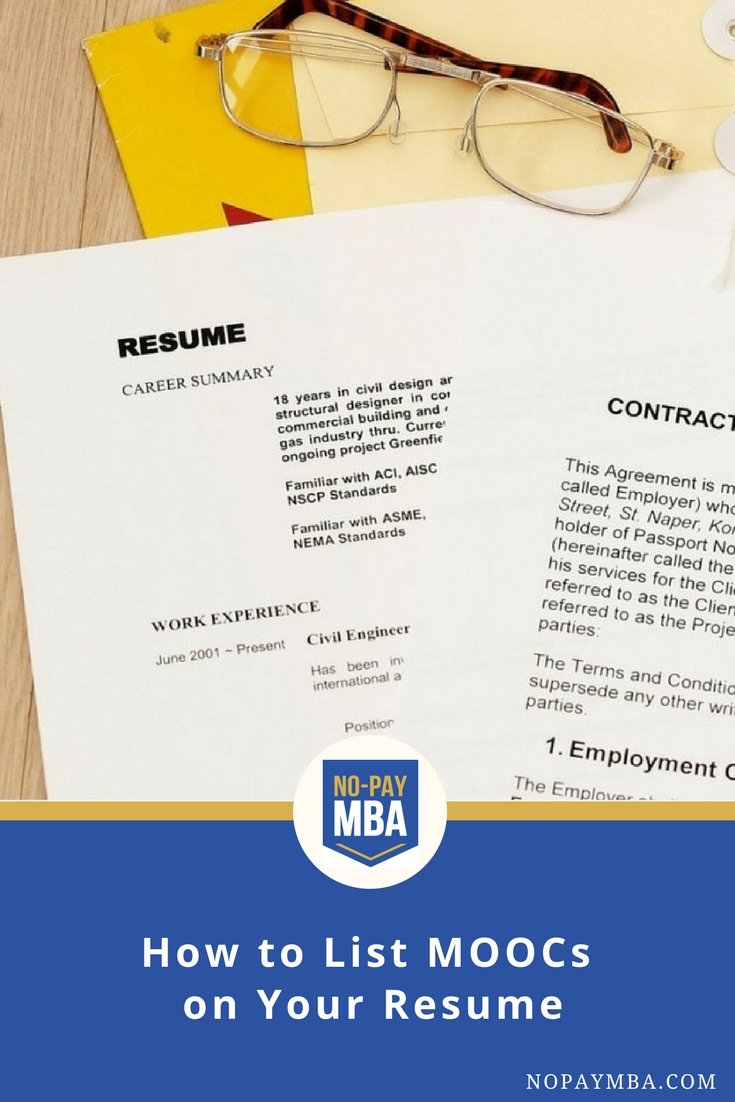
So you’ve finished a slew of business MOOCs. You’ve balanced T-accounts, analyzed throughput, calculated the net present value of an annuity, and considered the finer points of project management. Now you’re ready to leverage your new skill set in your search for a new job. What’s the best way to put a MOOC business education on your resume?
How do you showcase your MOOC coursework on your resume?
I’ve been asked this question many times – in comments on the blog, in emails from readers, and in interviews with the media. It’s also a topic I cover in my new book Don’t Pay For Your MBA. Fortunately, there is no single right way to put MOOCs on your resume.
My high school English teacher used to say, “All writing is creative.” While your resume should be based in fact, not fiction, you can absolutely use some creativity when highlighting your MOOC-based business education. Below are four places MOOCs might show up on your resume. Be sure to download the free resume template that accompanies this post for more advice on how to showcase MOOCs on your CV.
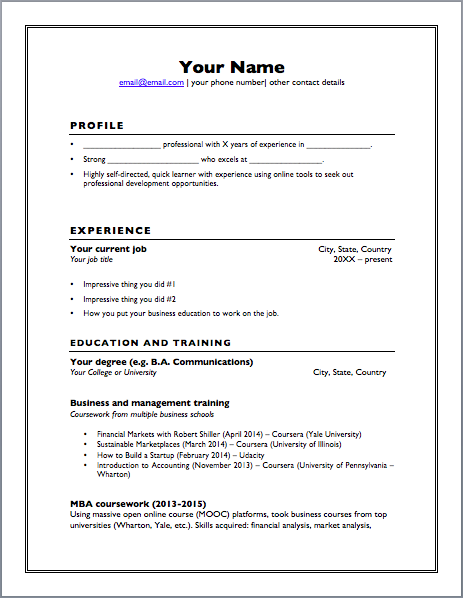
Your Professional Summary
The first place you might put your MOOC education is in a professional summary at the top of your resume. In addition to other information about your professional history and goals, you could add a line like, “Self-directed, quick learner with experience using online tools for professional development.”
Not everyone uses a professional summary on their resume, but if you do, this is one place your MOOC education can appear in a subtle way. This allows you to start painting a picture of yourself as a self-motivated, self-directed learner.
Your Experience Section
If you’ve used anything you learned in a MOOC to achieve real outcomes on the job, you should absolutely brag about that experience on your resume. When I’ve talked with recruiters about candidates who have used MOOCs to get ahead in the job market, they all say that experience is more important than education. So, if you got the education and it translated into direct experience, you should absolutely play up that experience. You don’t even have to include the name of the course you took. Instead, you can just focus on your accomplishments.
Your Education and Training Section
This is where you’ll talk about your MOOC coursework most explicitly, by actually listing some or all of the courses that you took. If you took a set of courses that you put together yourself, give your education a title - for example, “Advanced Business Courses” or “Master’s-Level Business Coursework.” (The resume template lists several options.) Then list the most relevant courses you took, including the universities that offered them and the dates you completed them. If you took a pre-packed set of courses, such as a Coursera Specialization or an edX Micromasters, you can simply list it.
You might also want to include a sentence describing your education (many people are still unfamiliar with MOOCs) and include a few of the skills you learned. For example, you could say something like: “Using massive open online course (MOOC) platforms, took business courses from top universities (Wharton, Yale, etc.). Skills acquired: financial analysis, market analysis, business planning, product development.
If you are listing individual courses, include only those that are relevant to your industry. And don’t list a lot of intro-level courses. Instead, focus on the most advanced coursework that is most specific to your job aspirations.
Your Skills Section
Finally, you might include a special Skills section of the resume, where you list some of your more relevant business skills, including those that you learned in your MOOC coursework. Like the Professional Summary, this is a section of the resume that not everyone uses. If you choose to include it, make sure you aren’t simply repeating information from earlier in the resume.
I’m interested to hear which of these options for listing MOOC coursework on a resume you find most appealing, as well as other ideas that I haven’t thought of, or any approach you are already using. And if you’ve managed to use MOOCs to score a new job, let’s hear how you did it!
by Laurie Pickard | Nov 10, 2016 | Career Development, MOOC MBA Design, Most popular posts, Thoughts on Higher Ed and Life
If you’re looking for affordable business education and credentials to show your skills, you may want to consider these options.

First published May 17, 2015. Last updated November 10, 2016. This post contains affiliate links.
I first published a version of this post just after the University of Illinois at Urbana-Champaign released their entire MBA program through Coursera and announced that you could earn a bona fide MBA degree from them via MOOC. Students would still need to go through the regular admissions process and be accepted to the business school, and they would pay $20,000 for verified certificates and other fees, but this was (and remains) the first full MBA available 100% through MOOCs.
Since then, we’ve continued to see a proliferation of new business credentials that you can earn through online study, ranging from certificates for single courses to U-IL’s iMBA, with a lot of new options in between. While most of these credentials don’t enjoy the same level of recognition as a full-scale MBA, there is reason to believe that some form of credentialing could be valuable in the job search. And at a price many thousands of dollars less than a traditional MBA, the cost-to-value of these new credentials has the potential to be quite high.
Here is a rundown of the current options for both degree and non-degree credentials when studying business online, in ascending order of cost.
The Smartly MBA
Cost: $0
One of the newest and potentially most disruptive credentials out there is the Smartly MBA. This highly selective program admits just a few top performers (as demonstrated by prior work and educational experience) to earn an accelerated MBA in just 4 months. Content is delivered through an interactive app. While this is not a MOOC-based option, some of Smartly’s content is available to the public. Which is a good thing because only a small portion of those who are excited about Smartly’s free (though as yet non accredited) degree program will actually make it through the admissions process.
Coursera Specializations
Cost: $200 - $600
When I first published this post, Coursera’s Specializations were new, and there weren’t very many of them. Now, you can find dozens of multi-course series on Coursera, typically consisting of 4-6 courses and a capstone project. The topics have gotten more specialized as well, including not just general business subjects such as financial management and entrepreneurship but also niche topics such as construction management and culture-driven team building.
Coursera has also recently introduced a new subscription-based payment model (something I suggested a while back, though at a higher price than I proposed) for certain Specializations, with fees ranging from $39 to $89 per month. This might make some courses cheaper, though if you tend to procrastinate it could also make them more expensive. While the value of Specializations in the job market is still relatively unknown, recruiters do report that they are seeing MOOCs on candidates’ resumes and that they generally view them positively.
This might make some courses cheaper, though if you tend to procrastinate it could also make them more expensive.
edX MicroMasters
Cost: $600 - $1700
The newest credential on the block is the MicroMasters, offered through the edX MOOC platform. As its name suggests, a MicroMasters involves master’s level coursework, but in a shorter, more condensed program. The first MicroMasters was created by MIT in the field of Supply Chain Management. The new crop of MicroMasters includes programs in Project Management, International Business Management, and User Experience Design, as well as non-business fields. The big advantage of the MicroMasters is that they shares a direct linkage with traditional master’s programs, allowing students who choose to do so to enter directly into a degree-granting program, with their MOOC coursework counting for credit towards the overall degree. Overall, the value to cost of a MicroMasters makes it a very promising option.
HBX CORe
Cost: $1950 - $3600
Harvard Business School’s Certificate of Readiness (CORe) is an interesting one. Harvard being Harvard, the business school has created its own platform, HBX, through which to deliver a small set of business courses. CORe is a sort of mini-MBA, covering just the foundations of an MBA program, designed for people with no previous business background. The big advantage of this program is the Harvard name.
There are a few attractive features of CORe. First, having a credential from Harvard, even if it isn’t a full degree, is bound to be worth something. If you can get the Harvard brand name onto your resume for $2000, even when other more affordable options are available (such as the Wharton Business Foundations Specialization), it might well be worth the price. Second, the HBX is more interactive than many of the MOOC platforms. It still operates on cohorts, and it has an admissions process. Admitted students are invested in the program and the level of engagement is high, which translates to added networking benefits. Finally, HBX also offers an option to take CORe for credit. The price of the for-credit option is double, at $3600, but it could be a good option if you’re planning to do a full-scale MBA in the future.
Professional certifications
Cost: in the range of $2,000 - $5,000
Many professional business certifications are available online, most of them offered through professional associations. Organizations like the Project Management Institute, the Institute of Management Accountants, the Information Systems Audit and Control Association, and many others all offer professional certifications. The advantages of these professional certifications is that they are very specific, and many are very well-recognized within their industries. The disadvantages are that you typically need to already be a practicing professional in order to reap the benefits of the certification, or even to become certified. Being so specific, these narrow credentials aren’t as versatile as an MBA, but within their respective industries they can be just as valuable.
Accredited degrees from low-cost online universities
Cost: $10,000 - $15,000*
*(varies significantly depending on how long you take to finish and how much credit you transfer in)
Several online-only universities offer low-cost MBA programs targeted towards working professionals. These include Western Governors, Capella University, and Excelsior College. All of these institutions allow students to study online at their own pace. Western Governors is a competency-based program, meaning that degrees are conferred based on the completion of projects. The advantages of these programs are the flexibility, the cost, and the fact that you can earn an accredited degree. The disadvantages are that if you take longer than expected to finish, you may end up paying more. And even though the degrees are accredited, the reputations of these schools aren’t as strong as, say, the University of Illinois.
University of Illinois’s iMBA
Cost: $20,000
As mentioned above, the University of Illinois is the first business school to offer a degree based on MOOC coursework. The big advantages of this program are the significant savings over other online programs, the flexibility of the program, and the reputability of the final degree. Downsides? $20,000 is still a lot of money, you’ll have to go through the admissions process and be accepted to the program, and you might still be missing out on some of the in-person benefits of an MBA. Still, if you need the degree and can afford the tuition, this is a great option.
Online MBAs
Cost: $60,000 to $100,000
Most of us are familiar with online MBA programs. Many universities offer online MBAs. The advantage of these programs is that they are just as well-recognized in the job market as brick-and-mortar MBAs. The downside is that the cost is equivalent – and sometimes greater – than what you would spend on a traditional, on-campus MBA program.
by Laurie Pickard | Oct 2, 2016 | Career Development
Online courses can help you get ahead, if you’re smart about how you use them.

This article originally appeared on the blog of the MOOC platform edX.
It’s official. Your MOOC coursework can improve your career. Last year, the Harvard Business Review reported on a survey of MOOC learners. Over 30% of those surveyed had experienced tangible career improvement as a result of their coursework, with 26% reporting that they had gotten a new job as a result of studying by MOOC. Others reported promotions, pay increases, and starting their own businesses. A whopping 85% of respondents said that they had experienced some kind of career benefit from having taken one or more MOOCs.
I’m not surprised by these results, as I am among both those who have been promoted and those who have started a business as a result of a MOOC education. I’m also the facilitator of a community of independent business students and have worked with a number of professionals who have used MOOCs for career advancement. I’ve also spoken with recruiters, who are increasingly seeing MOOCs on candidates’ resumes. Based on these conversations and experiences, here are five strategies for using your MOOC education to get ahead.
Five Strategies for Turning a MOOC Education for Career Advancement
Strategy #1: Develop skills and savvy across a range of subjects.
MOOCs are an excellent way to develop a wide range of skills and knowledge that may come in handy on the job. For students and early-career learners in particular, MOOCs are a good way to explore new areas while you’re figuring out how your career will take shape. This strategy is particularly useful if you are interested in working in a startup, on a small team, or in a small company where a broad range of skills may be required.
One exceptional learner, Joris Schut, took over 140 MOOCs over a two-year period, while simultaneously studying as a full-time master’s student. Joris formally studied Educational Science and Technology as well as Information and Library Science (he holds a master’s degree in each) and used MOOCs to supplement his education with topics like business strategy and R coding. After finishing his studies, Joris landed a job in a small design unit within Capgemini, a large IT/consulting firm in the Netherlands. He describes the work in his unit as “like running a startup inside a big organization.” As in any startup, versatility is required. “I can do strategy in the morning, chase down project managers at lunch, and code in R to automate sales reporting in the afternoon. A lot of what I learned through MOOCs, I apply here,” he says.
Strategy #2: Build and signal targeted skills.
At the opposite end of the spectrum, a MOOC education can be an excellent way to learn and demonstrate targeted skills. The recruiters I’ve spoken with are most positive about the resume-boosting benefits of skill-based courses. Learn to do data analysis in Hadoop, become an Excel whiz, or study supply chain logistics. Earn a certificate and build a portfolio of work to highlight on your resume, and this strategy just might make the difference between you and another candidate.
“Listing the course made the difference between her and other candidates. She got the job.”
Roberto Hernandez, founder of the recruiting agency Stffng, Inc., says that MOOC coursework is especially valuable when it builds concrete skills. For example, he tells of a candidate applying for a Sales Manager position whose resume included an online course on a particular software, which the employer relied upon heavily. “Listing the course made the difference between her and other candidates,” Hernandez says. “She got the job.” edX student Akshay Kulkarny employed the same strategy, using edX courses to build skills in Python programming and SaaS. His self-directed learning ultimately landed him a job at Microsoft.
Strategy #3: Accelerate along your current track.
These days, good career management requires continual learning and development. MOOCs not only keep your skills and knowledge fresh, they may also help you move up more quickly. Many MOOC students say that their coursework has boosted their confidence at work. That confidence can translate into new opportunities and may ultimately lead to promotion.
While it may be hard to quantify, I know this strategy works since it’s the one I used to score a promotion within my current organization in the field of international development. My MOOC coursework on business strategy, entrepreneurship, and finance helped me see increased scope to engage with private sector businesses interested in poverty reduction. I became a better representative of my organization was able to raise our profile with potential partners. My work ultimately earned me a promotion and a sizable raise. To get started with this strategy, simply search for courses related to your field and sign up for one or two that look interesting. With just a couple of MOOCs under your belt, you may be surprised by the opportunities you start to see.
Strategy #4: Learn the language of a new industry to prepare for a lateral move.
If you have significant industry experience and have long occupied a certain kind of role, a MOOC education can help you take that experience into a similar role in a different industry. For example, let’s say your functional expertise is in communications. You’d like to make a move from the corporate world to the nonprofit sector. MOOCs on environmental issues, business ethics, sustainability, and global poverty can help you better understand the issues and terminology you will encounter and help you make that shift.
One learner I work with is a physician who is orchestrating a move from clinical care to product development in a fast-growing healthcare startup. Courses in entrepreneurship and human-centered design taught him the language and worldview of startups. In job interviews, he has wowed interviewers with his unique combination of medical expertise and business acumen. He now has his pick of positions with several of the hottest startups in the industry.
Strategy #5: Build experience outside your current role, a.k.a. Job Jiu-Jitsu
While all the recruiters I’ve talked with express a positive attitude towards MOOCs, multiple have commented that work experience is best. Direct experience performing tasks that are similar to what will be expected in a future position, they say, is far more valuable than even a traditional university degree. If you’d like to orchestrate a big move in the mid- to long-term future, a MOOC education can help you with a strategic play that I like to call “Job Jiu-Jitsu.”
Here’s how Job Jiu-Jitsu works: Start by talking with your supervisor about your interest in taking on projects outside of your regular role. Explain that you are taking courses that have prepared you to do new kinds of work. Next, be on the lookout for projects that use your new skills, and volunteer when they come up. (Note that you can also take on special projects on a volunteer basis, outside of your place of employment.) Then, do an incredible job on the new work, making sure to produce outcomes that you can discuss in future job interviews. Finally, when you’re ready to make your move, highlight your work experience on your resume. You can choose to mention your MOOC coursework or not; your achievements are what matter most.
Whether you’re exploring your options, seeking targeted skills, or planning for a career transition, at least one of these strategies is likely to help you get ahead. Be sure to comment below if you’ve already seen career benefits from using one of these techniques!
by Laurie Pickard | Apr 24, 2016 | Career Development, MOOC MBA Design, Most popular posts

I am not a tech person. I do not have the mind of an engineer. I spent my childhood reading library books and pretending to be a ballerina, not taking apart electronic gadgets or building Lego towers. At one point, just before starting graduate school, I remember consciously considering what it would be like to get off the technology train and just stick with what I knew. That was in 2006.
When I started graduate school, I was decidedly tech phobic. I was studying geography, and one of the requirements of my master’s program was two semesters of geographic information systems, GIS. At that time, GIS software was quite technical, requiring knowledge of SQL, database logic, and an ability to enter terms exactly into a command bar in order to produce a result. I was terrified.
But then something remarkable happened. I took my first semester of GIS, and I actually liked it. It was a grind, the software was clunky, and it could take hours to produce single decent map, but when it worked it was amazing. Even more important than making maps, GIS helped me conquer my fear of adopting new technology.
Which is a good thing because over the next several years I got a Gmail account, joined Facebook, created my first blog, and started using cloud storage. Let’s just say it was the right decision not to drop out of technology in 2006.
One of my early maps using GIS
The thing is, these days, technology is not an option. We are all required to be tech people, at least on some level. Just for a second, allow me to channel my husband and think like an economist. If you’re studying business or planning to do so, you are trying to increase your productivity as a worker. Ultimately, increasing your productivity - the value you are able to produce in a given amount of time - is what drives your ability to command a higher salary. Productivity is a function of your skills, knowledge, and abilities in combination with the technology you are able to use.
The second half of that equation - technology - is not to be overlooked. I am not talking about your ability to create new technologies as a programmer or engineer. That is a different skill set - and a highly valuable one indeed. But no matter what your profession, and even for those of us who are much more poet than quant (myself very much included), there is absolutely no excuse for not becoming proficient at using ordinary workplace technologies.
A few words of encouragement for the technologically challenged or out of date. First, technologies have gotten a lot easier to use. Second, some of the simplest things you can do to improve your productivity are also the most impactful - like increasing your typing speed. Third, there are a TON of resources out there to help you.
The main purpose of this site is to help you get a graduate-level business education using the resources of the internet. Massive Open Online Courses (MOOCs) are the bread and butter of that undertaking. But university MOOCs don’t tend to focus much on concrete skills like making PowerPoint presentations or managing your email inbox, vital skills that you should absolutely master during your time as a business learner. Fortunately there are now plenty of ways to teach yourself new technologies, using tutorials within the programs, with YouTube videos, or with short courses on platforms like Lynda or Udemy. Throughout the rest of this article whenever I mention a technology or give a tip, I will link to an online course if there is one I know of. (FYI, some of these are affiliate links, which means I stand to earn a small commission if you make a purchase. As always, I only link to material that I think you will find useful in your business education.)
Without further ado, for anyone who is studying or considering studying business on their own, here are 6 pieces of advice on how to get up to speed, boost your productivity, and set yourself up for your technology future.
6 Ways to Become More Productive While Studying Business
1. Become a faster typist.
It sounds simple, but one of the best things you can do to improve your productivity is to become a faster typist. Most jobs today require that you engage in some form of written communication, most commonly email. If you can increase your typing speed, you can dramatically increase your overall email throughput, and that can add up to hours over the year.
The average person types about 36 words per minute. Imagine you respond to 25 emails per day, averaging 200 words per email. If you could increase your typing speed from 36 words per minute to 90 words per minute (which is fast but attainable), you could save yourself over 300 hours per year. That’s almost 8 full work weeks! Here is one of several websites where you can test your typing speed.
2. Manage your email like a pro.
I am somewhat of an email fanatic. I have three email addresses - one for my day job, one for No-Pay MBA, and one personal account. I can’t stand letting my email build up. Which is why all three of my inboxes usually look like this.

You don’t have to hit inbox zero every day, but trust me, you will feel so much better if you can figure out a way to keep your inbox to less than a page. Because I feel so strongly about this, I have started helping friends, family, and colleagues to make a fresh start using a process I call Inbox Therapy.
If you’re interested, here is my process for Inbox Therapy:
- First, go through just your first 1-2 pages of emails and move all of those that you still need to deal with in some way to a folder called ‘Important’ or ‘To do’
- Next, archive all your other emails. Seriously. All of them.
- You may then move those emails from ‘Important’ or ‘To do’ back into your inbox
- Going forward, deal with all incoming emails immediately in one of four ways - delete it (or archive it), file it, respond to it (if responding will take less than 2 minutes), or keep it in your inbox for later. (But don’t let the save for later list grow to longer than 10 at the end of the week!)
If you’d like a more in-depth treatment of email management, I suggest this course on keeping your inbox to a minimum.

3. Get good at online coordination.
Whether your team is scattered across the globe or in cubicles on the same floor, much office coordination now happens online. The ability to manage shared documents, calendar invites, video conferencing, and other coordination software is key in the modern workplace. It’s also something that we stress quite heavily in the No-Pay MBA Network, given that we have members from San Francisco to Singapore.
Below are some of the tools we use to stay organized. If you are ever planning to change jobs again, I recommend learning all of these, even if your current organization doesn’t use them. All of these technologies are widely used by businesses of all sizes, and are completely free or have a free version, so there is no excuse for not learning the basics.
Slack. The best messaging app around. Allows conversations to be organized into “channels,” which group members can opt into or out of. Integrates with everything. Gini Courter, who has taught workplace software classes for 20 years, offers this primer on Slack through the Lynda platform.
Trello. A visual project management tool that lets you put tasks onto “cards” and then move them through a workflow (e.g. to do, doing, to review, completed). Commonly used in software development, Trello has migrated to other industries. I like this beginner course on Trello, which explores some of its more commonly used features.
Zoom. I searched high and low for an affordable video conferencing program that would let larger groups participate with both audio and video. Zoom is by far the best in the biz. Functionality out the wazoo. Video conferencing is social, though, which means that you can’t just pick your favorite and only use that. What happens when someone invites you to a meeting using another technology? Coming out of a business education you should be capable of using Skype, Google Hangout, Go-To Meeting, Join.me, FaceTime or any other video conferencing program that comes your way. This is key not just for team coordination, but also for job interviews, sales calls, and networking. (But if you ever end up in a meeting that I’m hosting, be prepared to use Zoom.)
Google Calendar. Calendar invites are another small signal of your professionalism. I love Google Calendar for its ability to deal with multiple time zones - and the fact that it is free. Productivity and technology expert Jess Stratton teaches a short course on Google Calendar on the Lynda platform, which is a great place to get started.
Google Drive. I don’t mean to come across as a Google evangelist, but the suite of tools housed within Google Drive is incredible. With this free program, available to anyone with a Google account, you can create shareable documents, spreadsheets, slide presentations, and surveys. Being able to share and edit documents in real time is critical to collaboration on team projects. While there are other platforms for document sharing and collaborative editing, Google Drive is ubiquitous and free. If you ever expect to be on the job market again, you should know how to use it. Jess Stratton also offers a beginner course on Google Drive, giving you exactly what you need to start using this powerful tool.
4. Learn some basic design skills.
“Content is king,” Bill Gates declared in 1996. Those words were prophetic indeed. We have become gluttons for content, gobbling up YouTube videos, Medium articles, and BuzzFeed posts, always hungry for more. Even if it isn’t the organization’s core business, almost every organization, whether for-profit, nonprofit, or governmental, is in the business of creating content.
Individual workers, too, must create content from time to time. From the slide presentation you deliver to your extended team to drafting an email newsletter, most jobs require some ability to organize and present information visually.
But where do you start, if like me, you are graphic-design challenged? Luckily, you don’t have to learn Photoshop in order to make decent-looking visual communication products.
If you’re frustrated with Power Point, the web-based presentation program Prezi is a great alternative, allowing you to create dynamic, visually compelling presentations that capture the big picture. This course on Lynda is a good place to get started learning Prezi.
If you’re creating images for web or print, Canva is an excellent, easy-to-use, free program, also with a nice Lynda course to help you get started.
5. Employ robots to do routine tasks. (Optional)
This one I’m throwing in just for you personal productivity whizzes who are looking for a new way to up your game. A few newer apps like Zapier and If This Then That (IFTTT) allow you to sync up web applications to create automated tasks flows. For example, you can automatically save Gmail attachments to Dropbox. Or automatically create a Trello card each week for a recurring responsibility.

If you don’t do many routine tasks, you may not have an immediate use in mind for this kind of application. However, I am convinced that going forward the most productive people will be using automated workflows to do more and more of their routine work. Zapier is my favorite of the automation apps I’ve tried. I have several “zaps,” as they’re called, going at any given time. Udemy has a good starter course on Zapier if you’re interested in giving it a try.
6. DON’T STAGNATE.
This last item is more a rule than a tip. The point is that it’s not enough to master the list of popular productivity technologies of today. Rather, it is incumbent upon you to continually update your personal operating system. If you don’t, you send a not-so-subtle signal to your colleagues that you are out of date, that your skills have gotten dull. While your mind may be as sharp as ever, by ignoring or failing to learn new technologies you diminish your professionalism. Your goal is to become nimble enough with technology to continue to pick up the latest technologies throughout your career.
If you are in danger of sliding out of date, here are some habits you may want to adopt:
- Try out one new app per month. This article on the best new apps for iPhone and this one for Android are good places to start.
- Start listening to one of the many technology-focused podcasts, such as those listed here.
- Volunteer to learn a new technology and teach it to your team at work.
- If you have a hobby or side project or belong to any organizations, channel your enthusiasm for your passion project into learning a new technology - for example starting a blog site or creating a visual communication product with a new design software.
One of the best things you can do during your business education - whether self-administered or university-led - is to double down on your commitment to boosting your productivity and getting up to date on the latest technologies. That, dear readers, is my challenge to you. May you embrace it with gusto.

